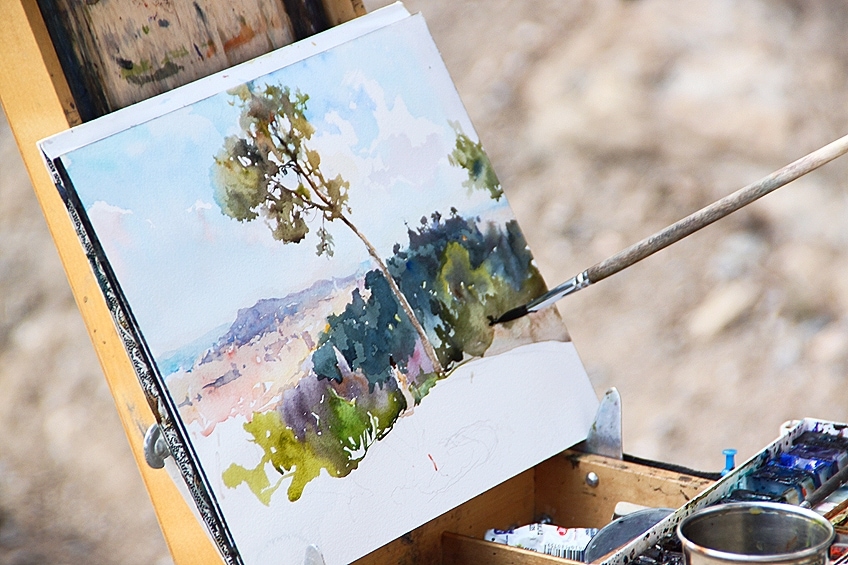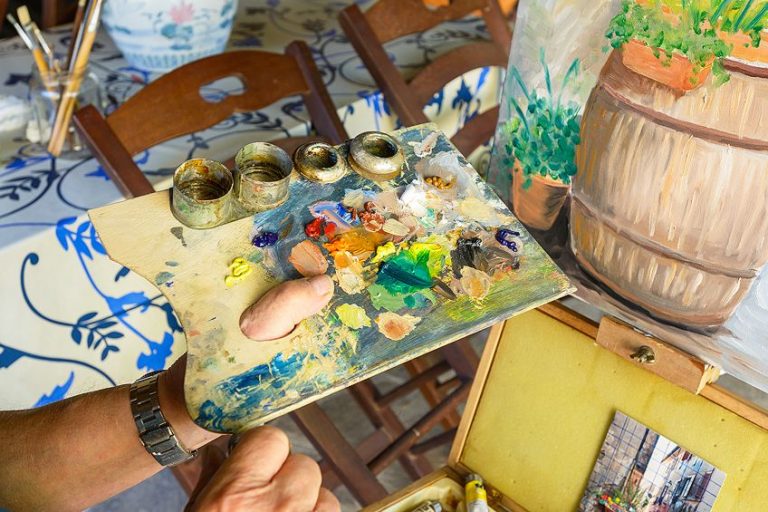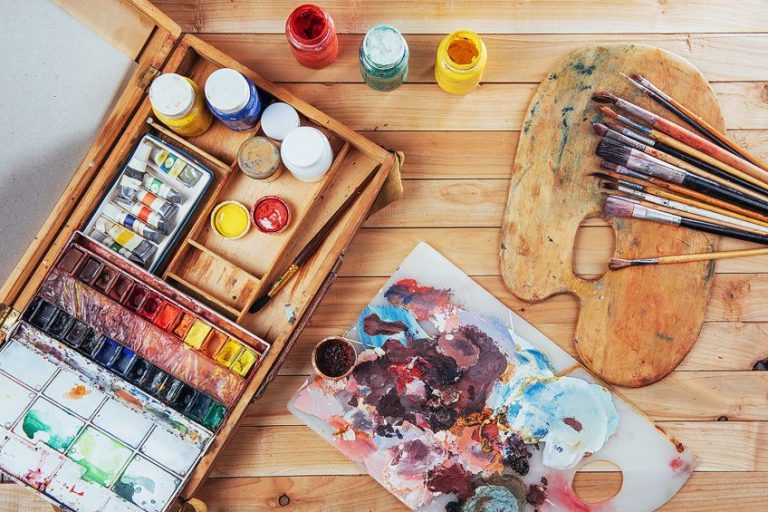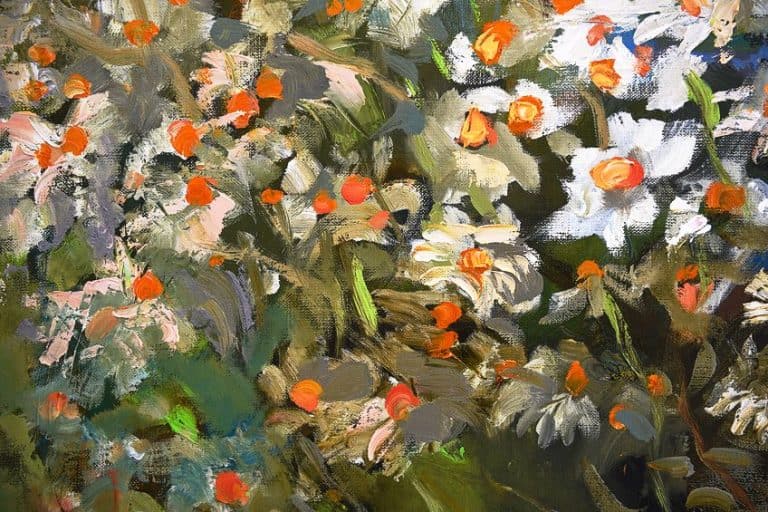Oil Painting for Beginners – A Novice’s Guide on How to Use Oil Paints
Oil paint has been around for hundreds of years and was a favorite to artists such as Da Vinci, Salvador Dali, Michelangelo, and Rembrandt. The reason oils are such a great medium is because of their great texture and layering capabilities within your artwork. For those just beginning oil painting, this article will provide you with some helpful oil painting tips as well as a guide on how to use oil paints to achieve the best results in your work.
Table of Contents
Oil Painting Basics
Oil paints are hugely popular not only for their textures and techniques but also for their brilliant hues and color options. For those who have worked with acrylics before, oil paint will not seem very different based on the texture or consistency of the paint itself.
However, having an oil base, they do take much longer to dry. Oil paints also require the use of potentially harmful chemicals and solvents to create different effects and to achieve various painting techniques, unlike your acrylics, which are water-based and therefore safer to use. Below, we have outlined some oil paint basics, which will assist in getting you better prepared on how to use oil paints for the first time.

Organize Your Space
Setting up your art studio at home is often an underestimated first step. This is important as you need to make sure that you not only have the right materials and tools for the job, but also the right space. This could be in a well-lit room in your home or even under a shady tree outside. Good ventilation is key when working with oil paints and solvents. Also, make sure that you have set up a drop cloth or an old sheet over the floor to prevent mess. The oil will not come out of fabric easily.
Start Small
Often when starting a new project, we tend to get excited and want to go big on our first attempt. While this is a personal choice, many find it easier to learn something new by starting small and not being overwhelmed with too much on your first try. Take your painting process step by step until you are comfortable in starting a larger project with more elements.
Try out various techniques on different surfaces and a smaller canvas in order to get a feel for which ones you enjoy doing and which ones you may need to work on a bit more. Once you have found your groove, you may be the one giving out oil painting tips of your own!
Choosing Your Oil Painting Surface
The beauty of oils is in their versatility. They can be used on different surfaces such as canvas, paper, or wood. Certain canvas options already come primed for use with oils, but you can also purchase a primer or gesso and do this step yourself. The purpose of a primer is to prevent the oils and chemicals in your paint from damaging the surface area. It also provides a base coat that assists your paint in better adhering to this surface.
When beginning oil painting, it can make life easier to use a thicker paper and then move onto canvas or wood options when you are more comfortable.
The Right Oil Painting Tools
Aside from your color palette options, quality paintbrushes are also a must with oil painting. This does not mean you need to go out and buy a huge set of the most expensive brushes. Starting out, it is helpful to buy a small set of up to three or even five differently shaped and sized brushes. Purchasing loose or single brushes when you need a top-up or a specific size is an option too with all paintbrushes.
Synthetic brushes can be used with oil painting, and natural hair paintbrushes are also an option but will be pricier. Brushes made from hog hair are most popular when it comes to oil painting.
Oil paints can be expensive, especially when looking for a professional or reputable brand. There are some great options though, that will not cost a fortune and that are great for beginners. Just like your paintbrushes, these can come in sets or as single paint tubes. When thinking about how to use oil paints, it may be better to purchase a full set that includes all the materials, as it would be more cost-effective and easier to get all your supplies at once. This also has the benefit of working out cheaper when you need to top up one or two colors in the future.
While easels and paint palettes are not always seen as necessary, they certainly do have their advantages, especially when dealing with a long-drying paint like oil. Using an easel will make it easier to sit or stand comfortably while you paint and give you a safe spot for your painting to rest and dry on in-between coats or layers. If you like to take your art with you, there are smaller table easels that come in handy too. Your paint palette will assist you in playing with colors and blending different shades. These usually come in plastic or wood, but ceramic options are also readily available and are very easy to clean up.
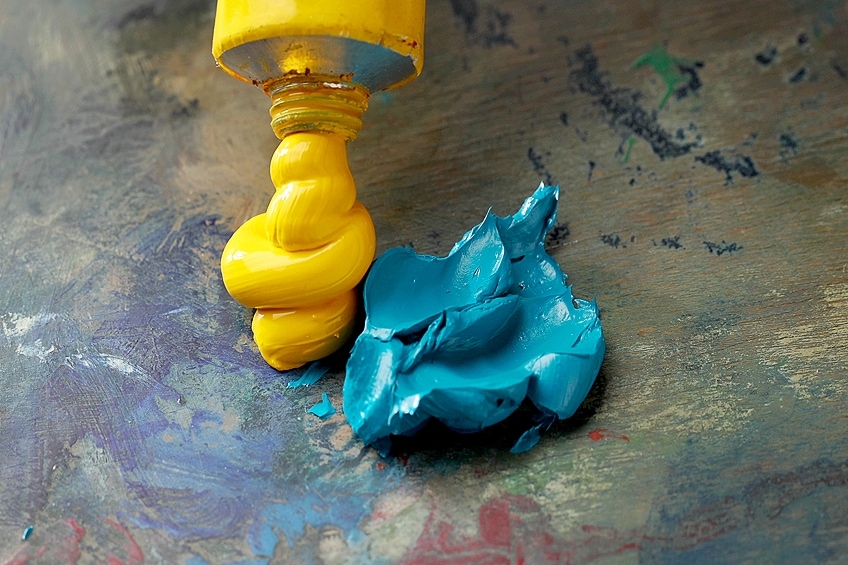
Cleaning Your Brush
Cleaning your paintbrush is a rule of thumb when you are done painting with any medium. But did you know it is also beneficial to clean while painting or in-between coats when using oils? This is to protect and ensure the longevity of your bristles, as well as to add sheen to your painting. Cleaning your brushes can be done using a mixing medium or by using an artist soap. Choosing solvents to clean your brushes is effective, but they can also damage them and eat away at the casing and the bristles.
As with other paint mediums, you can keep your solvent and possibly some water in two small cups or containers with you while you paint. Once you have dipped your brush in the medium or solvent, wipe it with some paper towel to rub the paint off. Then mix it in your water cup, rub it onto your artist soap, rinse, and dry off again. Practicing this will ensure long-lasting paintbrushes.
Working with Oils, Solvents, and Chemicals
We all know by now that oil cannot be mixed with water. When using oil paints this is no different. To best thin your paint, clean your brushes, and properly apply certain techniques, you will need to get yourself an oil mixer medium.
Mixer mediums that are most used with oil paints are usually other oils, such as linseed, walnut, or safflower oil. These are safer and more natural options that will add a soft, glossy sheen to your work.
Some do prefer the use of stronger solvents like paint thinners and turpentine, which are much more dangerous and should not be used without wearing protective gloves or a mask. Your chemical or solvent usage also needs to be monitored in order to prevent over-applying on your actual painting, as these will eat away at it or can cause the surface to bubble.
Framing Your Oil Painting
You may or may not decide to frame your oil paintings once you are done. The benefit of using a frame with a glass piece in it is that your work will be safe and not easily damaged. If you choose not to use a frame with glass, you can apply a fixative spray or sealant coat to your art so as to prevent smudging and damage over the long term. The tricky thing with oil paints are that they can take up to six months for each layer in your work to completely dry. So, try to put it in a safe place where it will not rub up on anything until it is ready for this step. In summary, the oil painting basics you will need to get started are:
- A clean, well-lit, and ventilated area;
- A dropcloth to prevent spills and messes;
- An easel for easy painting while standing or sitting;
- Quality oil paints;
- Three to five differently sized paintbrushes;
- A pre-primed surface area (or one that you will prime);
- An oil mixer or chemical solvent for mixing colors, painting, and brush cleaning;
- A container for the mixer medium and container for water;
- A paint palette for a better color-mixing experience;
- A fixative or frame to preserve your work.
The Best Oil Painting Tools for Beginners
Now that you know where to start, the next step is to move on to which products to begin oil painting with. Below, we will look at our top product recommendations for those beginning oil painting for the first time.
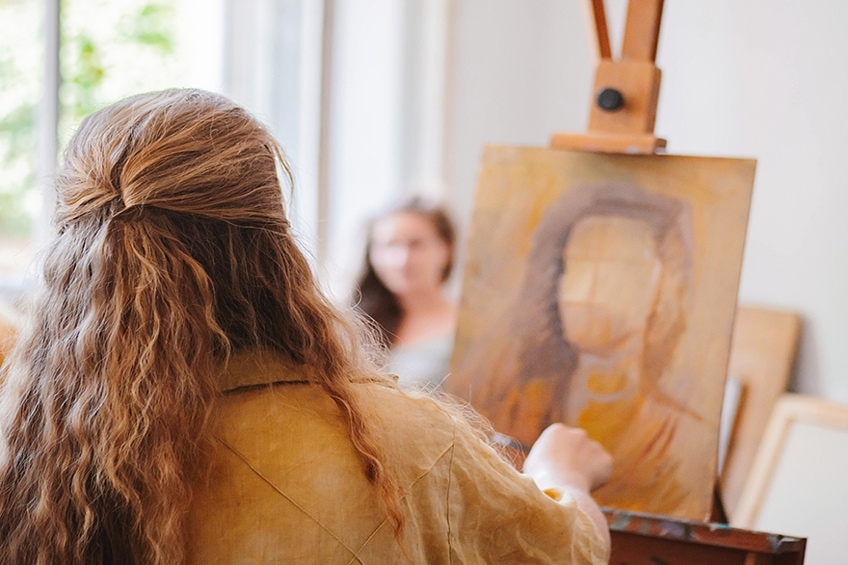
The Simplest Oil Painting Guide for Beginners: The Oil Painting Course You’ve Always Wanted by Kathleen Lochen Staiger
Kathleen Staiger is the author of this step-by-step guide on how to oil paint. This book, available in both kindle or paperback versions, will instruct you on various oil painting techniques for beginners as well as tips and tutorials, covering still-life painting, landscapes and portraits, brush control, techniques, and color mixing. Each topic is explained in easy-to-read diagrams and includes illustrations and demonstrations for easy reference. Having taught oil painting for over 35 years, it is no surprise that after taking her classes, many of Kathleen’s students have galleries and exhibitions of their own. Now, you could have one too!
- Crystal-clear, step-by-step lessons that build to reinforce learning
- Topics are covered in clear text, diagrams, illustrations, and exercises
- Learn about brush control, color mixing, painting landscapes, and more
Pros
- Simple, easy-to-use guide
- Detailed exercises and demonstrations
- Includes illustrations and diagrams
- Author has over three decades of oil painting experience
- Short, to-the-point book
- Available in kindle and paperback options
Cons
- Not available as a hardcover
Oil Painting Techniques for Beginners
Now that we know what products to use, we can discuss some oil painting techniques for beginners. Just as with other paint mediums, there are many techniques when using oil paints. Below, we will highlight the most popular ones for you in order to get a better idea on what you can accomplish with this medium.
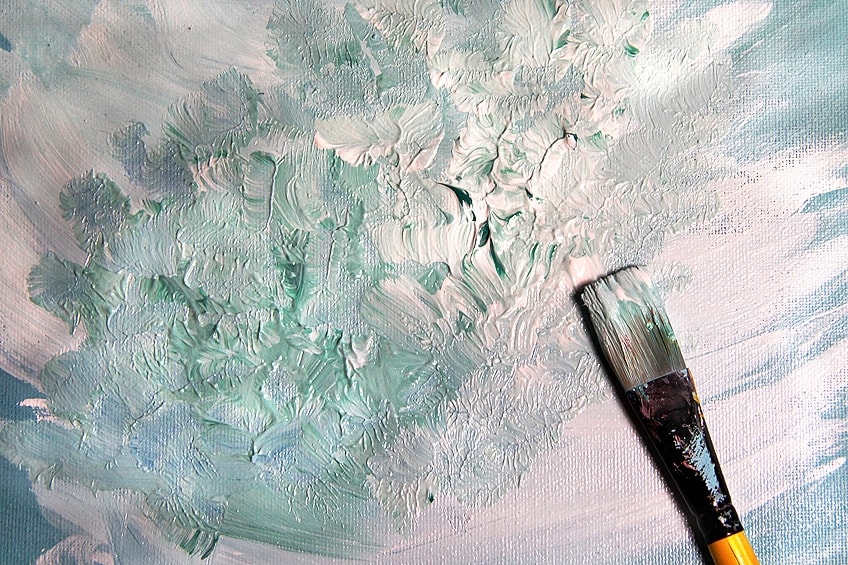
Underpainting
This technique is fairly basic and is the method of painting a fine base coat over your canvas in just one color. This will include the outlines and shadows as well as the background. The purpose of an underpainting is to provide a foundation for your oils to build off of and to allow for the use of shadows and depth.
Scumbling
This is also known as dry brushing. Scumbling utilizes a small, yet thick application of paint on your brush, where you use quick, short strokes to add texture. No thinning agent or medium is used for this technique, as you need your paint to be thick. This style can also be used to soften edges and details in your oil painting.
Alla Prima
This style refers to a wet-on-wet oil painting technique. This means painting your entire oil painting without giving your layers a chance to dry. What makes this method so popular among oil artists is the fact that it speeds up the time in which you can complete a full oil painting, allowing for a single day’s work rather than a few days or a week. To achieve this technique, some other mediums may be required.
Glazing
Unlike alla prima, glazing uses the same concept, except you wait for each individual layer to dry before adding more color over it. The effects achieved here will be a noticeable texture and glossy layers, adding a sheen to your artwork.
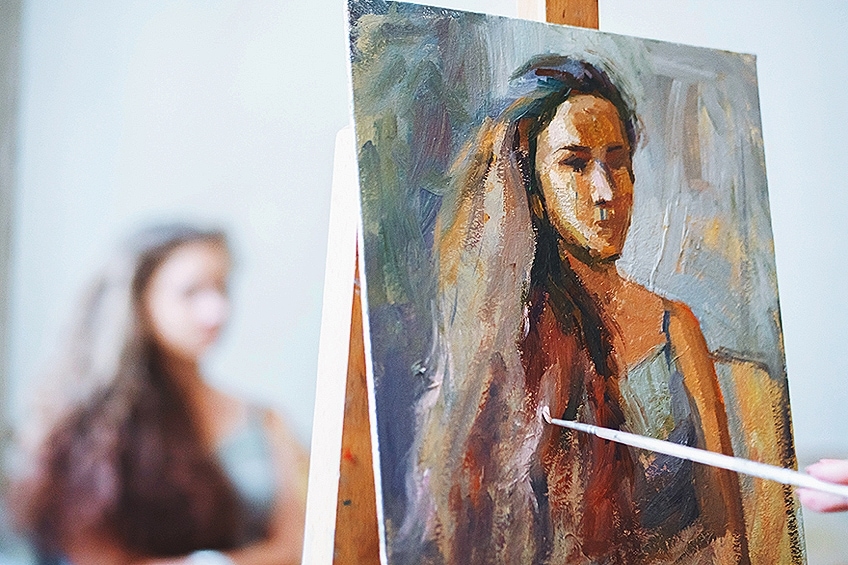
Impasto
A well-known technique, impasto makes use of broad and quick brush strokes, allowing for a more defined piece of art. This technique is best used for adding highlights, creating shadows, and adding depth. To achieve the best results, palette knives and painting tools are used with impasto work.
Sfumato
Opposite to impasto, sfumato is a softer and gentler approach. It allows for smoothing sharp edges or softening harsh outlines. The key with this technique is to always use a soft and clean brush for each new color of oil added to your canvas.
Being aware of the various oil painting techniques makes your possibilities with oils endless! Now, we will take a look at oil painting step by step with our oil painting tutorial below.
Oil Painting Tutorial
For this tutorial, we are going to look at doing a still life oil painting step by step. This tutorial will cover the materials you will need as well as detailed instructions on how to achieve your very own still life oil painting.

Materials You Will Need:
- Oil paints
- Brushes
- Drop cloth
- Palette knives and tools
- Paint palette
- One canvas
- Acrylic or an acrylic marker
- Containers with water and mixer medium or solvent
- Roller towel
How to Oil Paint
- When first beginning oil painting, you will need to decide on a subject or subject matter to paint. The go-to when oil painting for beginners is to start with something easier, such as a still life. Often, taking a photo of your object and working off of that can be easier than trying to beat the sun’s shadows and loss of daylight. This step can also be useful in using your photo to trace outlines onto your canvas with tracing paper or grid paper.
- Roughly sketching your drawing beforehand will assist in eliminating errors or misjudging lines and shapes. For this preliminary drawing, you can use a light pencil, diluted acrylic or oils, and even charcoal. This medium will need a fixative before going over it with your paint, however, in order to prevent smudging and to protect your colors. Another popular and easy-to-use option for sketching is an acrylic marker.
- A helpful suggestion to remember is to try to find different colors or shapes that tie in the various components of your painting together. It is helpful to find a theme and add hints or connecting elements to that when starting. It can also be beneficial to try your ideas on paper before going straight to the canvas, as this way you can get a feel for the colors, shapes, and elements you would like to include.
- Once your sketch is done, the next step would be the background for your oil painting. This base coat acts as an absorbent layer or foundation for the rest of your painting, which will prevent it from drying out or cracking. This layer should be applied thinly in either oil or acrylic paint and allowed to dry before continuing.
- The next question is whether you want a colored layer or a black or white layer for the background. This would depend on the theme of your painting; are you wanting a warmer tone or a cooler one? If you would like a cooler undertone and darker shadows, then a darker or cool color will work best in the background. Using white as a background will inevitably brighten up the other colors once they are applied, adding highlights and possibly a warmer tone.
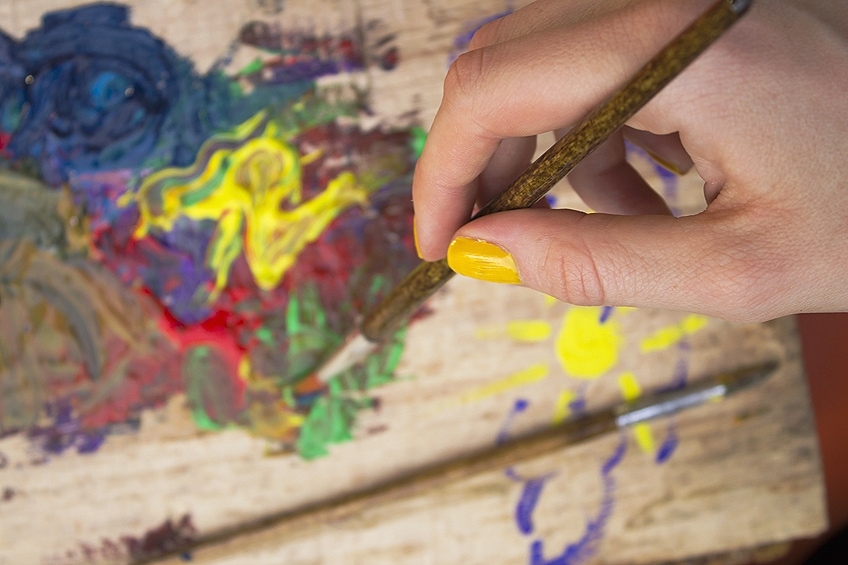
- When it comes to adding color to your oil painting, the idea is to add layers so as to achieve the desired texture and realism. You want to start with your shadows and by adding in light. Then, move onto the areas needing to be filled with color. This method will be repeated until you are satisfied with the result.
- The most important rule to remember when learning how to oil paint is the ‘thick on thin’ method. This is to say that each layer that is added will be thicker and have more color than the previous layer. In order to ensure this is the case, you will need to slowly dilute the initial layers, making them less and less diluted each time you add on one. Doing your painting without following this rule can lead to flaking or peeling layers of paint.
- Your final layer or add-on to your oil painting will consist of very light strokes. The goal is to tie everything together with lighter tones in order to draw the eye. To get the best results, use your white accents or shadow colors straight from the tube to highlight specific details or features. For these accents, you do not need to water your oils down.
- The last rule – possibly even more essential than the rest – is to allow enough dry time. This is crucial between layers of paint as well as at the end before framing or sealing your painting. If your oils are still wet, they will be damaged. Although, if you are not keen on the wait time, the alla prima method would be the perfect quick oil painting option.
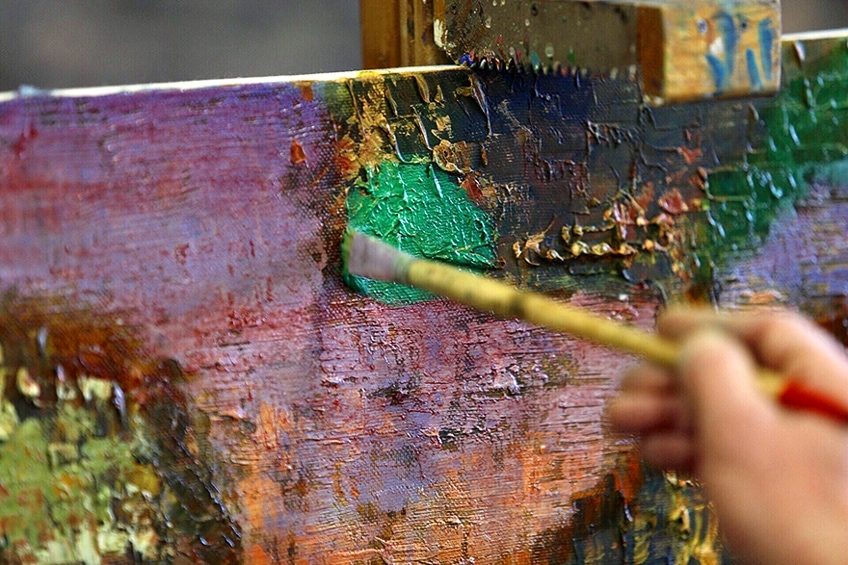
Now that you are all clued up on the basic oil painting techniques, we hope that you have fun exploring this medium and all of its possibilities!
Frequently Asked Questions
What Is the Best Oil Paint for Beginners?
There are many reputable and quality brands to choose from when it comes to oil paint. Some good names include Winsor & Newton, VanGogh, Gamblin, and Sennelier. Beginners can also use these brands, however they may find them to be more expensive.
How to Oil Paint?
Just as with any other form of artistry, oil painting is a skill that will need time to be perfected. There are many online videos and tutorials that will explain oil painting step by step. However, the only real way to learn anything is to start!
What Do I Need to Start Oil Painting?
Thankfully, you do not need much when you are first starting out. It is easier to start small and build up your paint and art tool supply as you go along. When first starting, the main things you will need are a canvas or paper, oil paints, a minimum of three differently sized oil brushes, and your oil or chemical mixer. Should you have the option of starting with an easel or paint palette, these will be highly beneficial.
What Are Some Oil Painting Basics?
The basics of oil painting are quite simple. Five key rules to remember are that oils take a long time to dry; they can be mixed with other paint mediums; they will need the use of oil mediums or chemical solvents to be fully useable; when using oil, your brushes will need to be cleaned regularly; and oil paintings need to be protected.
In 2005, Charlene completed her Wellness Diplomas in Therapeutic Aromatherapy and Reflexology from the International School of Reflexology and Meridian Therapy. She worked for a company offering corporate wellness programs for a couple of years, before opening up her own therapy practice. It was in 2015 that a friend, who was a digital marketer, asked her to join her company as a content creator, and this is where she found her excitement for writing.
Since joining the content writing world, she has gained a lot of experience over the years writing on a diverse selection of topics, from beauty, health, wellness, travel, and more. Due to various circumstances, she had to close her therapy practice and is now a full-time freelance writer. Being a creative person, she could not pass up the opportunity to contribute to the Art in Context team, where is was in her element, writing about a variety of art and craft topics. Contributing articles for over three years now, her knowledge in this area has grown, and she has gotten to explore her creativity and improve her research and writing skills.
Charlene Lewis has been working for artincontext.org since the relaunch in 2020. She is an experienced writer and mainly focuses on the topics of color theory, painting and drawing.
Learn more about Charlene Lewis and the Art in Context Team.


